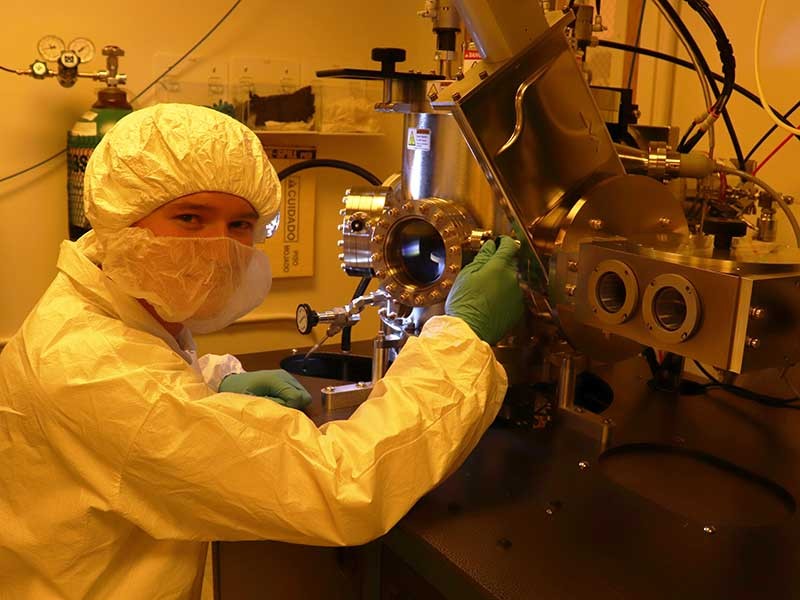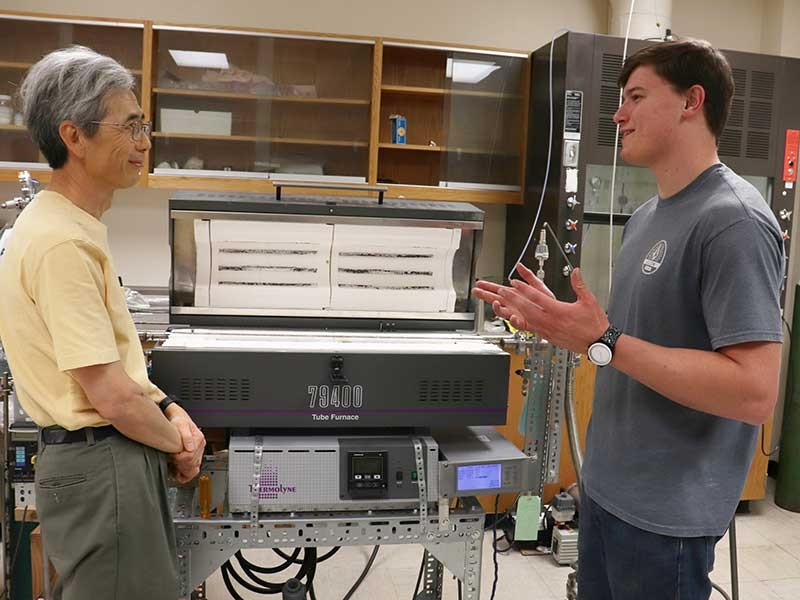The New Black: USU Physics Undergraduate Pursuing Nanoscale Research
By Mary-Ann Muffoletto |
In the amber light of USU's Nanoscale Device Lab cleanroom, undergrad researcher Christian Lange uses a sputter coater during the fabrication of carbon nanotubes. The Honors student received URCO and College of Science Minigrant research funding.
As a pianist, Utah State University undergraduate researcher Christian Lange knows that listening to a music is best, when it’s in a quiet setting. A silent atmosphere, where the listener can experience every lyrical nuance, every pause, every richly ornamented passage.
“The same is true when measuring light,” says the USU Honors student and physics major. “You want to eliminate any noise that could interfere with the measurement.”
Working with USU Physics Professor T.-C. Shen, Lange is creating black surfaces – ultra-black surfaces – the blackest of black surfaces, that can, perhaps, allow for greater visual and measurement precision for future optical applications.
“Making black surfaces has traditionally been achieved with paints,” says the 2017 graduate of Wyoming’s Evanston High School. “That is, a chemical approach. But a painted surface always has a limit to the amount of light and frequency ranges it can absorb. So, we’re trying a structural approach.”
Lange and Shen are growing densely packed carbon nanotube forests, but with a twist.
“The carbon nanotubes are incredibly thin,” Lange says. “If you lined up ten thousand tubes side-by-side, they’re about as thick as a single human hair. With the tubes vertically aligned, you can create a very dark surface or ‘forest.’ But we hypothesize that, by varying the heights of the tubes and creating a corrugated forest, you can make the surface even darker.”
Awarded a USU Undergraduate Research and Creative Opportunities (URCO) grant, as well as a College of Science Undergraduate Research Minigrant, Lange is forging ahead with his investigation. A large chunk of that effort this past summer has been learning to use varied instruments in the university’s Nanoscale Device Laboratory (NDL), including photolithography equipment and a sputter coater. To monitor the microfabrication processes and carbon nanotube growth, Lange is using the Scanning Electron Microsope (SEM) in USU’s Microscopy Core Facility.
Just entering the NDL cleanroom requires vigilant preparation. Lange carefully cleans dust from his shoes and dons a white, head-to-toe clean room “bunny” suit with a cap, mask and knee-high, lint-free boot covers.
“I’m learning new things every day and surprised by all the knowledge I need to pursue this project,” he says. “Not just physics, but chemistry, math and computer science.”
A Presidential Scholarship recipient, Lange says he chose USU because of its emphasis on undergraduate research and its piano performance program.
“Utah State is large enough that it offers a plethora of opportunities and allows me to pursue my different interests, yet it’s small enough that I can get to know faculty members one-on-one,” he says. “When I complete my undergraduate degree, I plan to apply to doctoral programs. Utah State is providing good preparation.”
At a USU-built chemical vapor deposition system used for carbon nanotube fabrication in the Nanoscale Device Lab, Christian Lange, right, talks with Physics faculty mentor T.-C. Shen. After graduation from USU, Lange plans to pursue graduate studies.
WRITER
Mary-Ann Muffoletto
Public Relations Specialist
College of Science
435-797-3517
maryann.muffoletto@usu.edu
CONTACT
T.-C. Shen
Professor
Department of Physics
435-797-7852
tc.shen@usu.edu
ADDITIONAL RESOURCES
TOPICS
Research 878stories Undergraduate Research 157stories Physics 99storiesComments and questions regarding this article may be directed to the contact person listed on this page.








